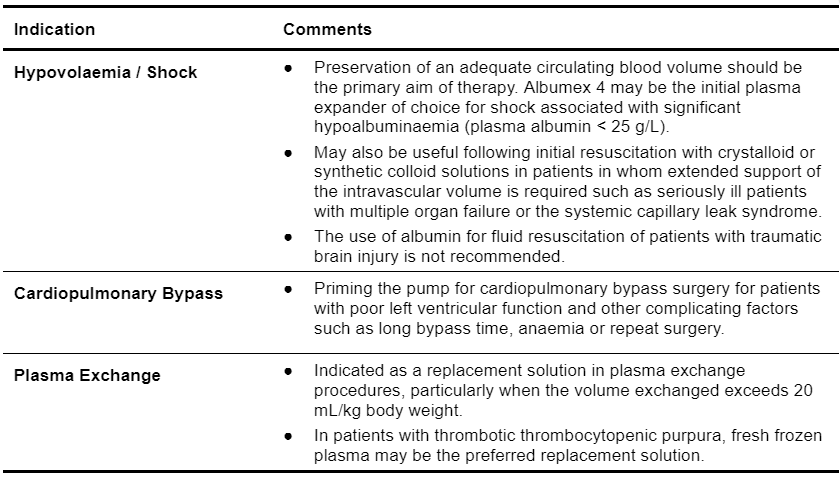Transfusion medicine
Transfusion medicine handbook
The Transfusion Medicine Handbook is designed to assist hospital staff and other health professionals in modern Transfusion Medicine Practice.
5. Fractionated Products
5.3.1 ALBUMEX 4 (Human albumin 4%)
Albumex 4 contains 40 g/L albumin in solution for intravenous injection and is iso-oncotic with human serum. It is available in vials of 50 mL and 500 mL volume. When infused into adequately hydrated patients its effect is to expand the circulating blood volume by an amount approximately equal to the volume of Albumex 4 infused. It is prepared by a combination of Cohn cold-ethanol fractionation and chromatography. The manufacturing process of Albumex 4 includes pasteurisation and cold temperature incubation to reduce the potential for viral transmission. The current procedures are effective for inactivation/removal of HIV, hepatitis A, hepatitis B, and hepatitis C and may also be of limited value against parvovirus B19.
Indications for Use
Table 5.11: Clinical Indications for Use of Albumex 4

Precautions
- Adverse effects
Adverse reactions to albumin solutions are uncommon and are usually mild and transient. Chills, fever, urticaria, flushing, nausea, headache and dyspnoea may occur. More serious allergic events including hypotension and anaphylaxis are reported. In addition, hypotension has been reported in patients given albumin who are on angiotensin-converting enzyme (ACE) inhibitors. - Aluminium accumulation
Albumex 4 contains trace amounts of aluminium (≤ 200 µg/L). Accumulation of aluminium in patients with chronic renal insufficiency has led to toxic manifestations such as hypercalcaemia, vitamin D-refractory osteodystrophy, anaemia and severe progressive encephalopathy. Therefore, when large volumes of albumin are contemplated for administration to such patients, serious consideration should be given to these potential risks relative to the anticipated benefits. - Circulatory overload
Circulatory overload can be avoided by monitoring the rate and volume of infusion. Patients with cardiac failure, renal insufficiency, stabilised chronic anaemia or on cardiopulmonary bypass are at special risk of developing circulatory overload. - Compatibility with other fluids
Albumex 4 should not be mixed with protein hydrolysates, amino acid solutions, solutions containing alcohol, or solutions containing drugs that bind to albumin such as calcium channel blockers. - Shock
Administration of albumin can aggravate myocardial depression when present in patients with shock.
Safety of Albumin for Fluid Resuscitation
In 2011 the Cochrane Injuries Group reported results of a meta-analysis of the available medical literature on “Human albumin solution for resuscitation and volume expansion in critically ill patients” and concluded that for patients with hypovolaemia there is no evidence that albumin reduces mortality when compared with cheaper alternatives such as saline. Contributing significantly to this report were results from the SAFE trial (Saline vs Albumin Fluid Evaluation) which compared the safety and efficacy of albumin versus saline in Australasian intensive care units. The study concluded that albumin and saline should generally be considered clinically equivalent treatments for intravascular resuscitation in the ICU although further study is required for more highly selected populations of critically ill patients, for example those with brain injury. The Cochrane report also concluded that for patients with burns and hypoalbuminaemia there is no evidence that albumin reduces mortality. Due to the increased cost of albumin compared to alternatives such as saline, albumin should only be used within the context of further trials.
